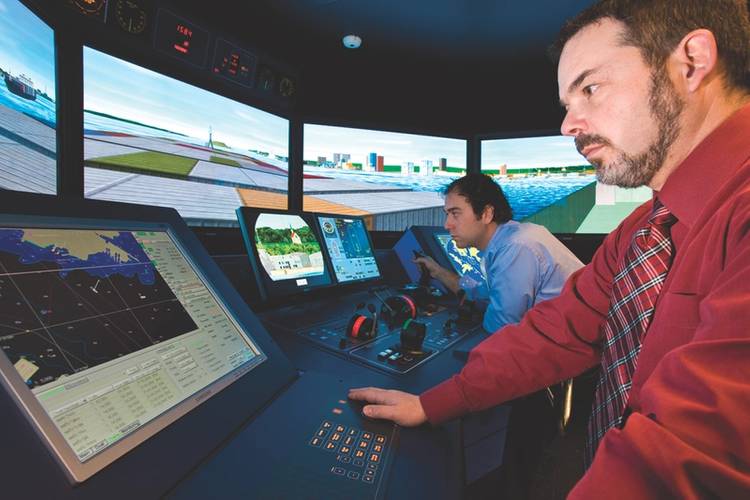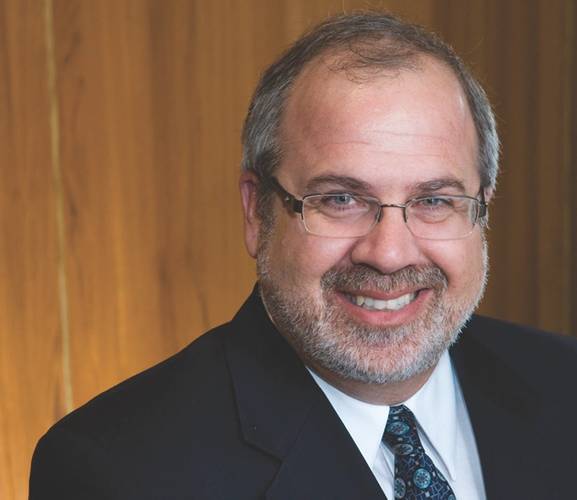In the world of maritime training, MSRC has carved a unique niche in the training of pilots. Founded in 2005, MSRC is a division of the Corporation of Lower St. Lawrence Pilots (CLSLP). The MSRC is a purpose-built simulator with a fully instrumented DNV Class “A” configured bridge with 330° visuals that exceed the requirements of the 1995 STCW Convention. MSRC’s Full Mission Simulator (FMS) is one of the most advanced simulators of its type and is continually being upgraded.
The Center is also equipped with three fully instrumented ship bridges, with a horizontal view of 240°. These bridges can be configured as standard or azimuth propulsion tugs that are specifically designed to support high fidelity tugging operations involving physical space constraints, ship design, overhang, limited push and pull attach points and turning radiuses. This capability is achieved by combining two critical operational components: purpose-built tug wheelhouses, which replicate the controls, layout, and tools used by a tug master and high fidelity mathematical models of the tugboat.
All four bridges are networked to a common simulation control system with two primary instructor control positions as well as a suite of self-contained, portable laptop simulator. The simulators are manufactured by Kongsberg Maritime. Having the possibility of using four interactive bridges allow for the bridge team, the pilots and tug operators to simulate the most realistic experience possible.
The Center also functions as a total turnkey port procedural development center. It has in-house capability for building geographic databases anywhere in the world and is one of the few facilities in the world offering a full range of simulation options spanning from single ship simulations to fully interactive, multiple unit tug and large vessel simulations.
MSRC is developing its own “Pilot grade” ship models and has an extensive library of more than 100 ship models (bulk carriers, oil tankers, container ships, LNG carriers, tugs, passenger ships, etc.). Each ship model is unique with maneuvering characteristics very faithful to those of the ship on which the model was based.
MSRC is the only school in Canada providing a Bridge Resource Management for Marine Pilots (BRM-P) course, and is also approved by the American Pilots’ Association to give this training. In addition, MSRC is the official training institution for the Portable Pilot Unit (PPU) software developed by SEAiq.
“In 2016, MSRC offered 138 sessions of 43 different training programs to 30 different groups of pilots and maritime companies for a total of 7,847 hours of training. It also developed several new ship models and geographic area databases for training and operational feasibility studies,” said Paul Racicot, Director, MSRC.
According to Racicot, continual investment in physical equipment and personnel is a must to keep up in today’s maritime training world. “MSRC invests in Human Resources as it continues to grow,” he said. “We have recently opened a new position for a full-time instructor. MSRC also constantly upgrades its software and hardware to keep its state-of-the-art equipment running at peak performance. Since its inception, MSRC has had a Long-Term System Support Program agreement with Kongsberg Maritime (KM). Through Premium Customized Care, KM assists MSRC to keep pace with advances in simulator technologies and applications. In addition to as-needed support and maintenance, KM completes annual upgrades to all MSRC’s simulation equipment (Every year, the Center shuts down for 14 days where all systems and software are updated, computers, graphic cards, etc., are replaced with newer and more robust versions). In the past two years, MSRC has upgraded many of the 60 in-house computers that run the systems.”
Pilot Training
At this time, there’s no regulation, whether Canadian, American, or international, that makes training compulsory for the pilots. But Racicot said that most pilot groups feel they need to maintain and upgrade their skills.
On their own the Corporation of Lower St. Lawrence Pilots (CLSLP) founded MSRC and purchased its own simulator 11 years ago to train its own pilots and began developing curricula specific to pilots. MSRC subsequently grew out of CLSLP as a dedicated central training hub.
MSRC trains pilot groups across North America and beyond.
“Each pilot group has its own strategies and goals for training but more and more are sending their pilots to us, in particular, because MSRC also builds customized pilotage databases and ship models that allow pilots to train in their own real-world conditions,” said Racicot. “For example, in our local pilotage areas along the St. Lawrence River, we’ve identified 15 different maneuvers that every pilot must be trained on within a five year period. We keep track of each pilot’s training record and personally follow up to ensure they get trained when they need to be – an initiative that other pilots groups are looking to adopt.”
Pilot training is a specialized niche and, with the advent of mega ships, it is becoming even more important for pilots to be trained in advanced shiphandling and navigational techniques. “Portable Pilot Units are also a welcome technology for pilots as the PPUs have become a hub of navigational data in addition to vessel systems,” said Racicot. “Combining PPU technology with pilot simulation training gives pilots more situational awareness than in the past. MSRC can provide PPU-related simulation training, again, by simulating specific pilotage areas customized to different pilot groups.”
A Promising Future
“An additional area of growth MSRC sees is in our other area of focus; operational feasibility studies,” said Racicot. “As mentioned, with larger vessels comes more requirements for ports to adapt as well as those who are onboard ship.
Stakeholders across the maritime industry such as port personnel and engineers are recognizing and adopting simulation as a necessary tool for validation of such engineering projects.”
Simulation allows for not only an entire exact representation of the geographic area but also of ship models as well to help collaborations with tug operators and the areas of navigation ships will need to transit. Simulation technology also enables the measuring and recording of data for review, and facilitates communication as it allows everyone involved to discuss the validity of potential operations and undertake any risk analysis needed in order to make informed decisions on whether or not to move forward.
“As an added value, when a port project is considered feasible to move forward, MSRC can provide the simulation training to pilots and help facilitate the coordination and communication of all parties,” said Racicot. “We see adoption of simulation technology in this area becoming more main stream every day, evidenced by the mounting requests MSRC receives from Engineering firms and Port Authorities to supply operational feasibility studies for new port infrastructures.”
















